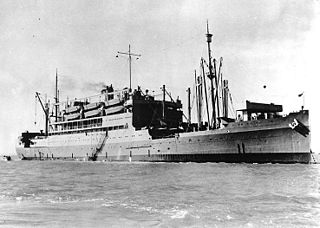
USS Arided (AK-73), a Crater-class cargo ship, is the only ship of the US Navy to have this name. She was named after Arided, the other name of Deneb, the alpha star of constellation Cygnus.

USS McCawley (APA-4) was a McCawley-class attack transport that served with the United States Navy during World War II. Named after Charles G. McCawley, eighth Commandant of the U.S. Marine Corps, she was the lead ship in her class.

USS Naos (AK-105) was a Crater-class cargo ship commissioned by the US Navy for service in World War II. Naos was named after the star Naos, in the constellation Puppis. She was responsible for delivering troops, goods and equipment to locations in the Asiatic-Pacific Theater.
USS Hyperion (AK-107), was a Crater-class cargo ship in the service of the US Navy in World War II. Named after Saturn's moon Hyperion, she is the only ship of the Navy to bear this name.

The second USS Perkins (DD–377) was a Mahan-class destroyer in the United States Navy before and during World War II and named in honour of Commodore George Hamilton Perkins an officer in the United States Navy during the American Civil War.

USS Crater (AK-70) was the lead ship of her class of converted liberty ship cargo ships in the service of the US Navy in World War II. She was first named after John James Audubon, an American ornithologist, naturalist, and painter. She was renamed and commissioned after the constellation Crater, she was the only ship of the Navy to bear this name.

USS Adhara (AK-71) was a Crater-class cargo ship in the service of the US Navy in the Pacific theater in World War II. Named after the star Adhara in the constellation Canis Major, it was the only ship of the Navy to bear this name.

USS Aludra (AK-72) was a Crater-class cargo ship in the service of the US Navy in World War II. Named after the star Aludra in the constellation Canis Major, it was the first ship of the Navy to bear this name.

USS Celeno (AK-76) was a Crater-class cargo ship in the service of the US Navy in World War II. Named with a variant spelling of the star Celaeno in the constellation Pleiades, it was the only ship of the Navy to bear this name.

The USS Alnitah (AK-127) was a Crater-class cargo ship in the service of the US Navy in World War II. Named a spelling variation of the star Alnitak in the constellation Orion, it was the only ship of the Navy to bear this name.
The second USS Kangaroo (IX-121), an Armadillo-class tanker designated an unclassified miscellaneous vessel, was the second ship of the United States Navy to be named for the kangaroo, a family of herbivorous, leaping, marsupial mammals of Australia, New Guinea, and adjacent islands. Her keel was laid down as Paul Tulane under Maritime Commission contract by Delta Shipbuilding Company, New Orleans, Louisiana, on 28 September 1943. She was renamed Kangaroo 27 October 1943, launched on 6 November 1943 sponsored by Mrs. Rufus C. Harris, acquired by the Navy on bareboat basis 17 December, and commissioned on 20 December.

USS Libra (AK-53/AKA-12/LKA-12) was an Arcturus-class attack cargo ship named after the constellation Libra. She served as a commissioned ship for 11 years.

USS Alhena (AKA-9) was an attack cargo ship named after Alhena, a star in the constellation Gemini. Robin Kettering had been purchased from Robin Line of the Seas Shipping Company some four months after launch and served as a commissioned ship for five years and four months. On 12 September 1946 the ship was transferred to the War Shipping Administration and placed in reserve until repurchased by Seas Shipping for operation as Robin Kettering. In 1957 the ship was sold, renamed Flying Hawk operating in cargo—passenger service until sold for scrap in 1971.

USS Alchiba (AKA-6) was an Arcturus-class attack cargo ship of the United States Navy, named after Alchiba, a star in the constellation Corvus. She served as a commissioned ship for 4 years and 7 months.
USS Constant (AM-86) was an Adroit-class minesweeper of the United States Navy. Laid down on 21 February 1942 by the Commercial Iron Works, Portland, Oregon, and launched on 9 May 1942, the ship was commissioned on 21 September 1942.

USS Boreas (AF-8) was an Arctic-class stores ship acquired by the United States Navy after World War I. She served with distinction during World War II, supplying food and other supplies to ships and installations in the combat zones of the Pacific Theater.

USS Taurus (AF-25), formerly SS San Benito, was a refrigerated banana boat of the United Fruit Company that may have been the first merchant ship to be built with turbo-electric transmission. From October 1942 to December 1945 she was a United States Navy stores ship in the Pacific Ocean theatre of World War II. She was scrapped in 1953.

USS Draco (AK-79) was a Crater-class cargo ship commissioned by the US Navy for service in World War II. Named after the constellation Draco. She was responsible for delivering goods and equipment to locations in the war zone.
USS Alderamin (AK-116) was a Crater-class cargo ship commissioned by the U.S. Navy for service in World War II, named after Alderamin, the alpha star in constellation Cepheus. She was responsible for delivering troops, goods and equipment to locations in the war zone.

USS Antares (AG-10/AKS-3) was an Antares-class cargo ship acquired by the U.S. Navy after World War I for use in transporting cargo. The cargo ship was named after Antares, the brightest star in constellation Scorpius. She earned two battle stars in service during World War II.
















